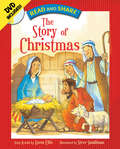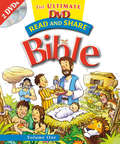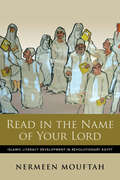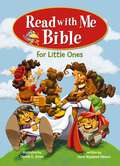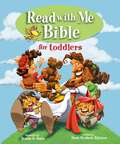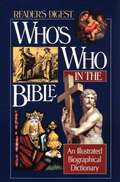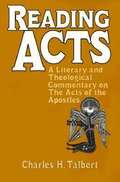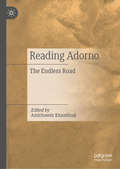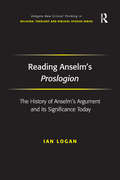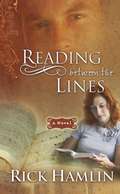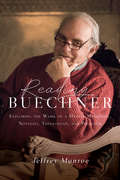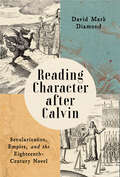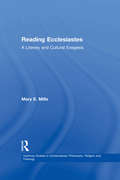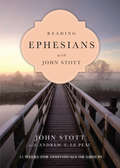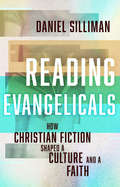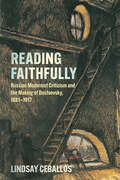- Table View
- List View
Read and Share: The Story of Christmas
by Gwen EllisThe Story of Christmas from the Read and ShareTM Bible is a colorful retelling of the birth of Christ and the events surrounding it.Based on the International Children's Bible, this book begins with the birth of John the Baptist. Next comes the angel appearing first to Mary, then to Joseph, the trip to Bethlehem, the birth of Jesus, the angel's announcement to the shepherds, the wise men and their gifts, fleeing to Egypt, and at last heading home to Nazareth. The "Can You Retell the Story" activity at the end of the book is a fun way for children to learn to tell the story themselves.The animated DVD includes a 15-minute story plus coloring pages and other bonus features.
Read and Share: The Ultimate DVD Bible Storybook - Volume 1
by Gwen EllisA book and DVD combination to help share the joy and wonder of God'sWord with the children in your life.These bite-size vignettes inbook and DVD presentations are perfect for the attention span of little ones,and give parents maximum flexibility to fit any time frame. This volumecontains more than 100 beloved Bible stories, including time-honored favoriteslike Creation, Adam and Eve, Noah and the flood, Abraham, Isaac, Jacob, Samson,Ruth and Naomi, Samuel, David and the Giant, Elijah, Esther, Shadrach-Meshach-Abednego,John the Baptist, Jesus' Birth, Stories from Jesus' Life and Ministry, Saul Becomes Paul, Paul's Travels,Paul's Shipwreck, and many more.
Read in the Name of Your Lord: Islamic Literacy Development in Revolutionary Egypt (Public Cultures of the Middle East and North Africa)
by Nermeen MouftahEgypt's January 2011 uprising spurred millions to action with a cacophony of demands—including the call to address Egypt's education crisis and adult literacy rates. Read in the Name of Your Lord traces the push for universal literacy as a project caught between revolutionary activism and Islamic reformism in post-Mubarak Egypt. Despite their many disagreements, religious reformers, revolutionaries, and state actors converged on literacy as the first step toward realizing aspirations of the revolution. They invoked the verse Muslims believe was the first to be revealed, "Read in the name of your Lord," to teach literacy as a religious duty and the foundation for the country's future. Nermeen Mouftah unravels how this religiously inspired push for universal literacy was born of twenty-first-century scripturalism and simultaneously went beyond the Quran, to make reading and writing virtuous acts of the liberal state. While revolutionary literacy campaigns soon vanished and adult literacy rates remained stubbornly low, their efforts revealed the importance of recognizing alternative modes of text processing and the personhood and knowledge of nonliterate people. Read in the Name of Your Lord demonstrates how the rise in modern scripturalism underpinned literacy activism, blurring the binary between secular and religious knowledge.
Read the Bible for a Change: Understanding and Responding to God's Word
by Ray LubeckWhich Bible passages are for us today and which only apply to the first audience ancient readers? Can we just pick and choose for ourselves the verses we think fit our situation? Who gets to decide?
Read with Me Bible for Little Ones
by ZondervanThe Read with Me Bible for Little Ones is this perfect way to introduce the Bible to young children. Featuring simple language and vibrant, full-color illustrations by Dennis Jones, this action-packed book is a great way to jump-start literacy and a love of the Bible.
Read with Me Bible for Toddlers
by Dennis Jones Doris RikkersThe Read with Me Bible for Toddlers: Children will love it. Vibrant, action-paced full-color art by Dennis Jones brings 24 of the Bible’s best-loved stories to life. Children will love looking at the pictures as you read the delightful simple words and short sentences. Share the excitement of God’s Word with your little one. Give them the Read with Me Bible for Toddlers!
Reader's Digest Who's Who in the Bible: An Illustrated Biographical Dictionary
by The Editors Of The Reader's DigestFrom prophets and kings to servants and beggars, the Bible is filled with fascinating characters whose stories make captivating reading. This comprehensive, A-Z arranged reference helps readers sort out these compelling and colorful personalities.
Reader's Guide to Judaism
by Michael TerryThe Reader's Guide to Judaism is a survey of English-language translations of the most important primary texts in the Jewish tradition. The field is assessed in some 470 essays discussing individuals (Martin Buber, Gluckel of Hameln), literature (Genesis, Ladino Literature), thought and beliefs (Holiness, Bioethics), practice (Dietary Laws, Passover), history (Venice, Baghdadi Jews of India), and arts and material culture (Synagogue Architecture, Costume). The emphasis is on Judaism, rather than on Jewish studies more broadly.
Readiness for Religion: A Basis for Developmental Religious Education (Routledge Library Editions: Education and Religion #5)
by Ronald GoldmanIn this study, first published in 1965, the author explores the implications of research for an alternative approach to religious education. The book deals with the psychological bases of religious development, reviewing the natural limitations as well as the basic needs of the young, and how religious education should be affected by educational theory and practice. The author also examines what content and methods of teaching are consistent with the healthy development of children and adolescents. Teachers in schools, students in training, lecturers, clergy and ministers, and local education authority committees will welcome the book as an important aid to the task of rethinking syllabuses and the need for more child-centred methods of teaching.
Reading 4: I Met You in a Story (2nd Edition)
by Bob Jones UniversityThe book includes stories around six character themes. It includes classic literature excerpts, character-building stories, and activities that build research and literary skills.
Reading 5 for Christian Schools: Pages in My Head
by Bob Jones UniversityReading 5 Student Text equips students to improve in reading, comprehensive and thinking skills. It contains a great collection of literature.
Reading 8 For Young Catholics
by Mary LynchThis is a workbook from Seton Press. Students develop reading and comprehension skills while learning to love the Church's heritage. Thirty-six lessons each contain a saint story and comprehension questions. Application of the book's content to daily Catholic life is encouraged.
Reading Acts: A Literary and Theological Commentary on the Acts of the Apostles (Reading The New Testament)
by Charles H. TalbertAnswers to the usual introductory questions do not yield sufficient harvest to enable an intelligent reading of Acts. The approach of Reading Acts is to ask how ancient Mediterranean auditors would have heard Acts when it was read in their presence. To be successful Talbert divides this approach into two parts--how Acts would have been heard in its precanonical context and in its canonical context.
Reading Adorno: The Endless Road
by Amirhosein KhandizajiThis book draws on core concepts coined by Adorno, such as identity thinking, the culture industry, and his critique of the autonomous and rational subject, to address the ills that plague neoliberal capitalist societies today. These ills range from the risk of a return to totalitarian tendencies, to the global rise of the far-right, and anti-feminist conceptions of motherhood. Subsequent chapters outline the ways in which Adorno's thought can also be seen to redress the challenges of modern societies, such as the critical function of artworks, and the subversive potential of slow-food and popular music. The important underlying concern of the book is to highlight the continuing relevance of Adorno, both in dealing with the failures of neo-liberal capitalist societies, and in his applicability to a wide range of disciplines.
Reading Anselm's Proslogion: The History of Anselm's Argument and its Significance Today (Routledge New Critical Thinking in Religion, Theology and Biblical Studies)
by Ian LoganAnselm’s Proslogion has sparked controversy from the time it was written (c.1077) to the present day. Attempts to provide definitive accounts of its argument have led to a wide and contradictory variety of interpretations. In this book, Ian Logan goes back to basics, to the Latin text of the Proslogion with an original parallel English translation, before tracing the twists and turns of this controversy. Helping us to understand how the same argument came to be regarded as based on reason alone by some and on faith alone by others, as a logically sound demonstration by its supporters and as fatally flawed by its opponents, Logan considers what Anselm is setting out to do in the Proslogion, how his argument works, and whether it is successful.
Reading Between the Lines
by Rick HamlinSought after by every agent and actress in New York, handsome casting director James B. Lockhart Jr. is at the top of his craft. Red-haired beauty Elizabeth Ash lives in a third-floor apartment and earns her living as a flutist. Both have loved deeply...but things haven't turned out as they'd hoped. Then Elizabeth discovers a story scribbled in purple ink in the margins of some old novels at a nearby church thrift shop. It moves her like nothing else has...and makes her long for something more. Jim has spent months mired in the past. Now he hopes to start a new chapter in his life...create a new beginning. But is that really possible after all this time? Or is it too late?
Reading Buechner: Exploring the Work of a Master Memoirist, Novelist, Theologian, and Preacher
by Jeffrey MunroeFrederick Buechner is one of the most gifted writers of his generation, and his legacy casts a long shadow over Christian letters today.
Reading Character after Calvin: Secularization, Empire, and the Eighteenth-Century Novel
by David Mark DiamondHow Calvinist theology helps us read characters in the early British novel, shedding new light on the origins of modern secularism The strangeness of fictional characters in the eighteenth-century novel has been well documented. They are two-dimensional yet complex; they suggest unstable correspondences between the external and the internal. In Reading Character after Calvin, David Mark Diamond traces the religious genealogy of such figures, arguing that two-dimensionality reproduces through form a model of interpretation that originates in Calvinist Protestant theology. In Calvin&’s teachings, every person possessed a spiritual status as saved or damned, and their external features ostensibly reflected this inward condition. This belief, however, was always haunted by the possibility of a discrepancy between the two. Diamond shows how Calvinism survives in the pages of early novels as a guide to discerning religious hypocrisy and, eventually, distinctions related to imperial race-making. He tracks the migration of Calvinist character detection from its original, sectarian contexts to the worlds of eighteenth-century fiction, revealing the process by which religion came unbound from doctrinal orthodoxy and was grafted onto the ambition of racialized global dominion. Analyzing a diverse set of texts, Diamond offers a fresh account of both how literary character worked and how it works to naturalize, question, or critique the violence of empire.
Reading Darwin in Arabic, 1860-1950
by Marwa ElshakryIn "Reading Darwin in Arabic," Marwa Elshakry questions current ideas about Islam, science, and secularism by exploring the ways in which Darwin was read in Arabic from the late 1860s to the mid-twentieth century. Borrowing from translation and reading studies and weaving together the history of science with intellectual history, she explores DarwinOCOs global appeal from the perspective of several generations of Arabic readers and shows how DarwinOCOs writings helped alter the social and epistemological landscape of the Arab learned classes. aaaaaaaaaaaProviding a close textual, political, and institutional analysis of the tremendous interest in DarwinOCOs ideas and other works on evolution, Elshakry shows how, in an age of massive regional and international political upheaval, these readings were suffused with the anxieties of empire and civilizational decline. The politics of evolution infiltrated Arabic discussions of pedagogy, progress, and the very sense of history. They also led to a literary and conceptual transformation of notions of science and religion themselves. Darwin thus became a vehicle for discussing scriptural exegesis, the conditions of belief, and cosmological views more broadly. The book also acquaints readers with Muslim and Christian intellectuals, bureaucrats, and theologians, and concludes by exploring DarwinOCOs waning influence on public and intellectual life in the Arab world after World War I. "aaaaaaaaaaa ""Reading Darwin in Arabic "is an engaging and powerfully argued reconceptualization of the intellectual and political history of the Middle East. "
Reading Ecclesiastes: A Literary and Cultural Exegesis (Heythrop Studies in Contemporary Philosophy, Religion and Theology)
by Mary E. MillsReading Ecclesiastes explores the literary style and themes of the Book of Ecclesiastes, investigating its overall theological messages and the cultural perspectives which readers bring to bear on their act of reading. Examining the meaning found in Ecclesiastes through the use of two important contemporary reading methods - narrative criticism and cultural exegesis - Mary E. Mills breaks new ground. Highlighting the range of theological meaning attached to the book of Ecclesiastes as a result of treating the text as a form of narrative and a story told in the first person, this innovative book will appeal to all those interested in narrative criticism, literary studies and interpretation and Wisdom tradition and the ancient world more widely, as well as biblical scholars.
Reading Ephesians with John Stott: 11 Weeks For Individuals Or Groups (Reading The Bible With John Stott Ser.)
by John StottThe Message of Ephesians
Reading Evangelicals: How Christian Fiction Shaped a Culture and a Faith
by Daniel SillimanThe story of five best-selling novels beloved by evangelicals, the book industry they built, and the collective imagination they shaped Who are evangelicals? And what is evangelicalism? Those attempting to answer these questions usually speak in terms of political and theological stances. But those stances emerge from an evangelical world with its own institutions—institutions that shape imagination as much as they shape ideology. In this unique exploration of evangelical subculture, Daniel Silliman shows readers how Christian fiction, and the empire of Christian publishing and bookselling it helped build, is key to understanding the formation of evangelical identity. With a close look at five best-selling novels—Love Comes Softly, This Present Darkness, Left Behind, The Shunning, and The Shack—Silliman considers what it was in these books that held such appeal and what effect their widespread popularity had on the evangelical imagination. Reading Evangelicals ultimately makes the case that the worlds created in these novels reflected and shaped the world evangelicals saw themselves living in—one in which romantic love intertwines with divine love, humans play an active role in the cosmic contest between angels and demons, and the material world is infused with the literal workings of God and Satan. Silliman tells the story of how the Christian publishing industry marketed these ideas as much as they marketed books, and how, during the era of the Christian bookstore, this—every bit as much as politics or theology—became a locus of evangelical identity.
Reading Expeditions: The Islamic World (a. D. 600-1500) (World History)
by National Geographic LearningJourney to the Arabian Peninsula and see how Islam developed among the nomads and townspeople and later spread through conquest and trade. Learn about the teachings of Muhammad and the basic duties all Muslims must perform. Discover the great advances of Islamic civilization in science, art, and literature.
Reading Faithfully: Russian Modernist Criticism and the Making of Dostoevsky, 1881–1917 (NIU Series in Slavic, East European, and Eurasian Studies)
by Lindsay CeballosReading Faithfully reveals how Russian critics of the Silver Age (the late nineteenth and early twentieth centuries) reread and remade Fyodor Dostoevsky for their era of religious renewal amid a broader political embrace of liberal reform and radical politics. Lindsay Ceballos argues that most Silver Age critics engaged in a mode of critique approaching religious faith: critical faith in the moral and artistic value of Dostoevsky that was needed to overcome their doubts about his nationalist rhetoric and politics. Surveying leading critics on and theatrical adapters of Dostoevsky's fiction since his death in 1881, Ceballos advocates for new kinds of critical engagement with his work that draw on the example of Silver Age faithful reading but embrace more complexity and dissonance than critics were able to achieve in that period of fracture and upheaval.Reading Faithfully provides a historical account of Russian culture in a pivotal period, bringing together literary, intellectual, and theater history into one narrative. Ceballos challenges Dostoevsky scholars, asking: What is the future of reading Dostoevsky in the wake of Russia's invasion of Ukraine?
